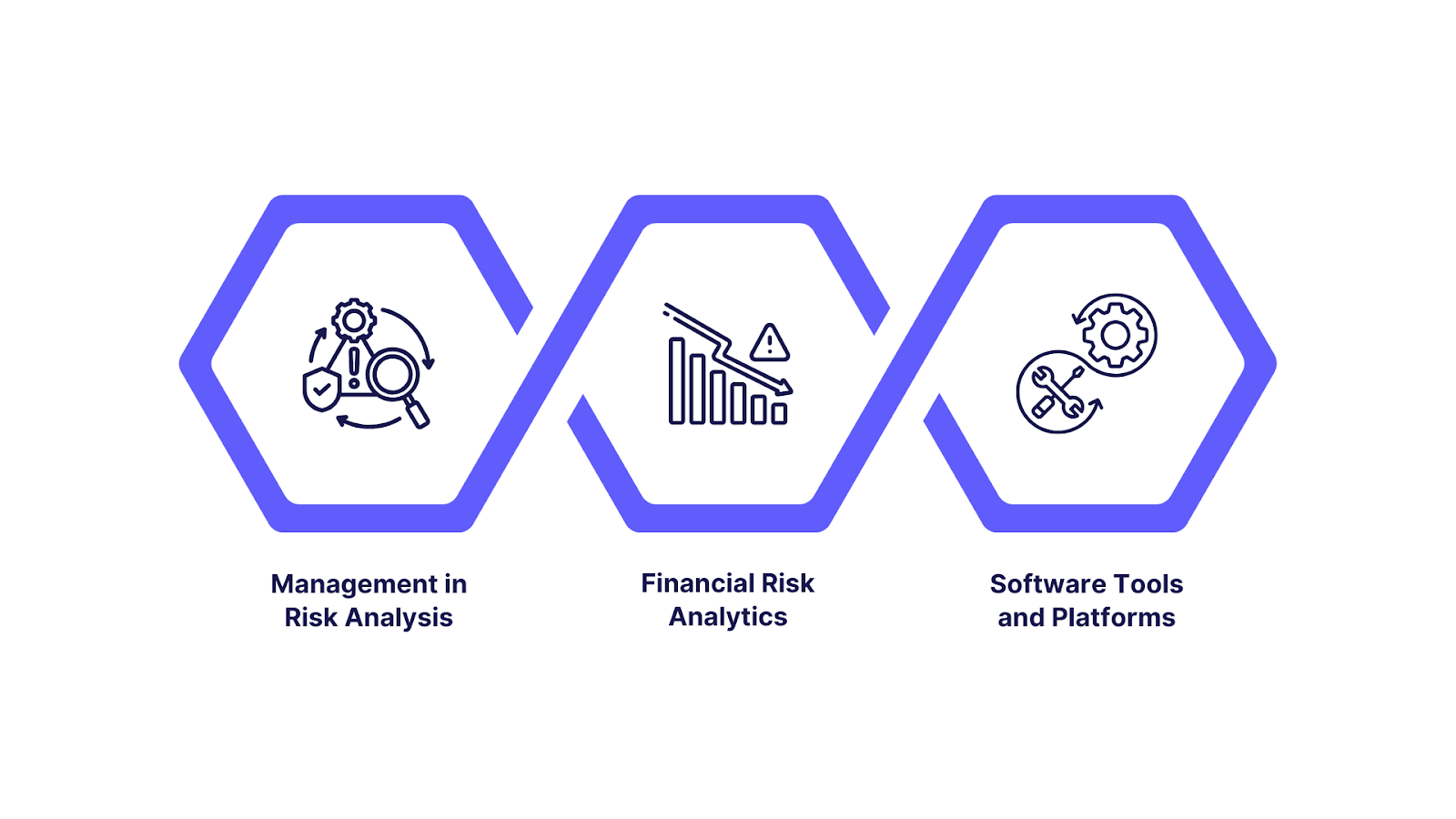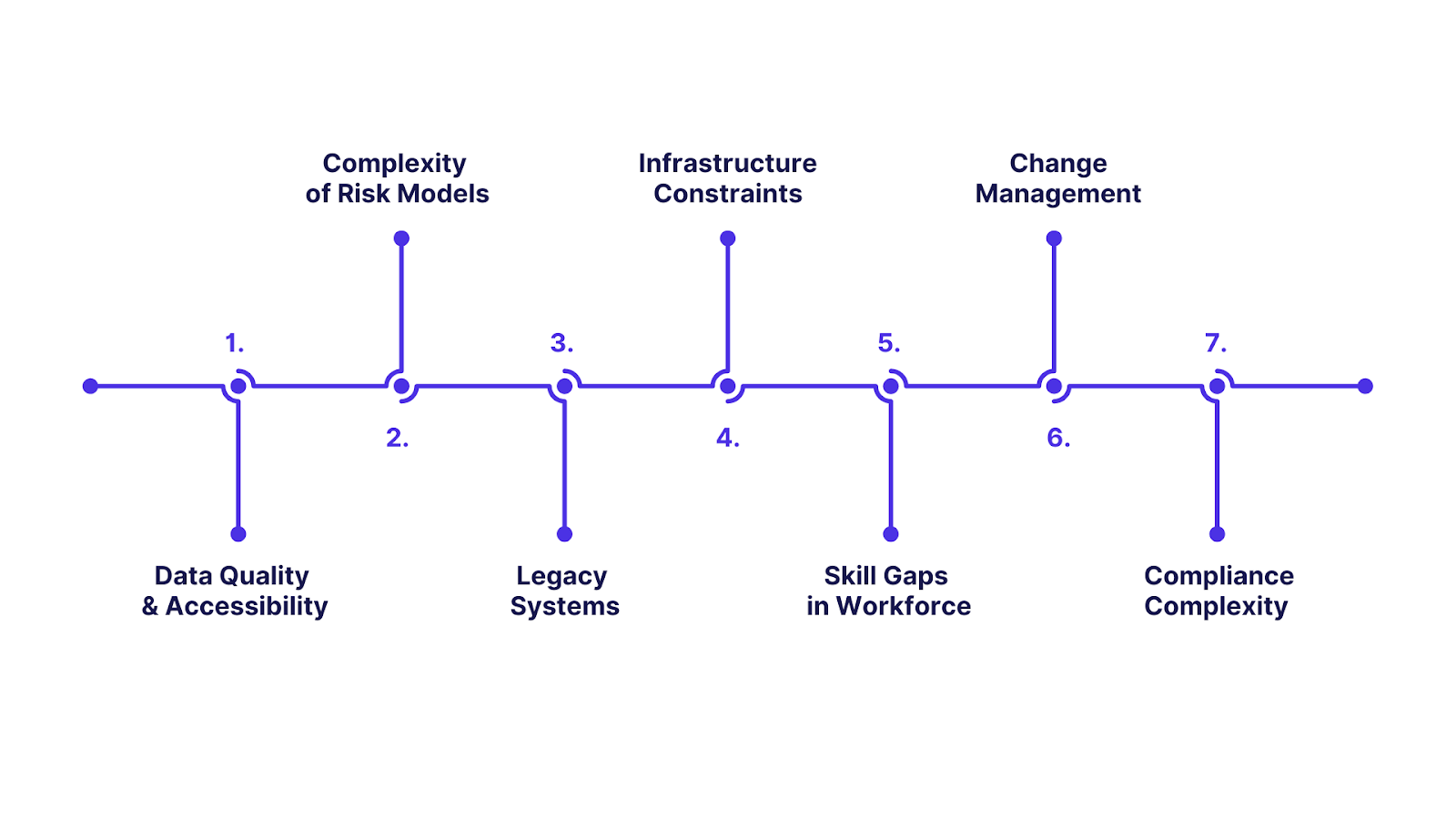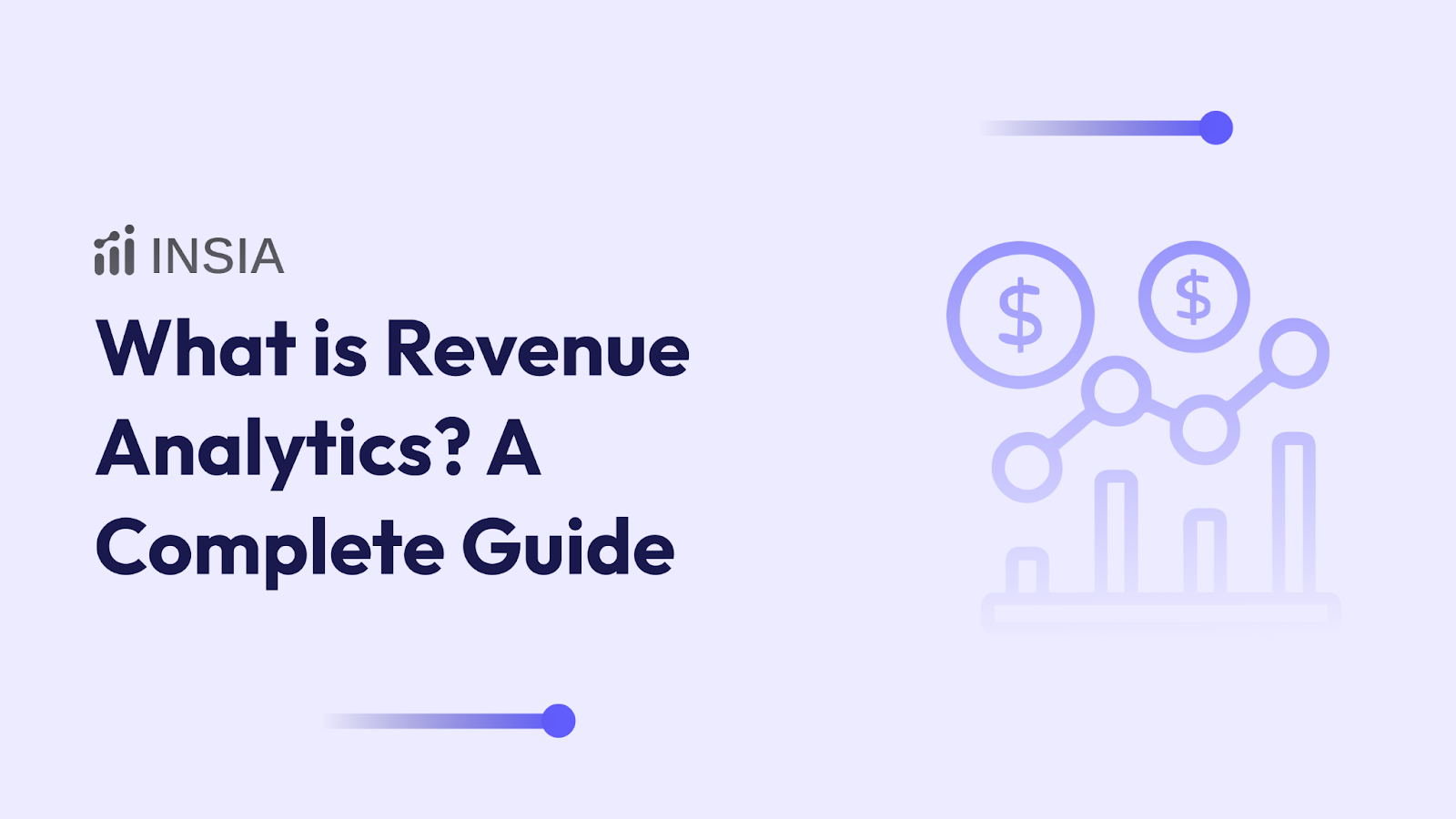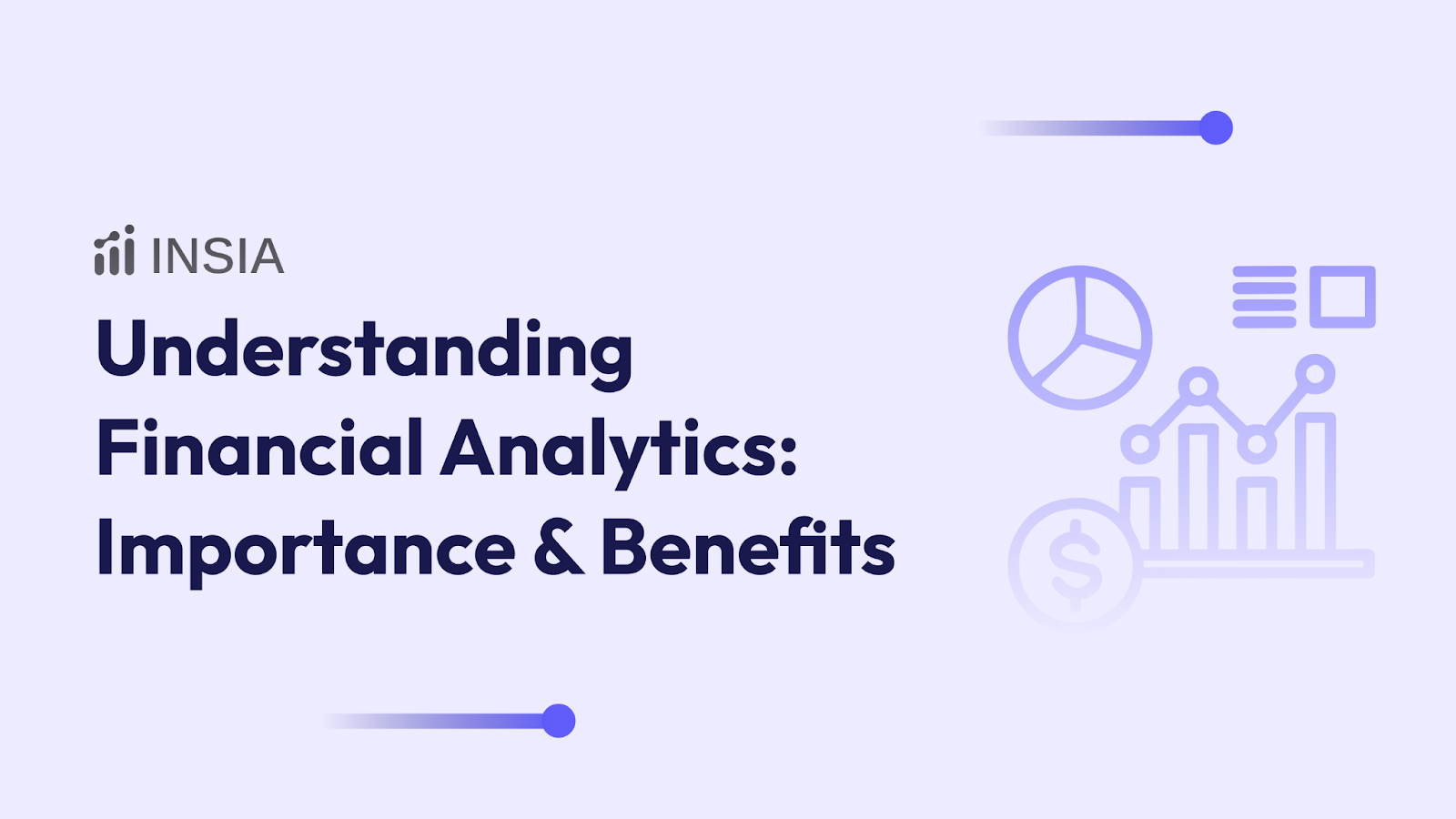In 2025, the global financial risk analytics market is projected to reach over $44 billion, growing at an annual rate exceeding 12%, underscoring the rapidly increasing importance of data-driven risk management.
For CFOs navigating today’s volatile markets, geopolitical tensions, and evolving regulatory environments, using advanced financial risk analytics is essential to protect business value and ensure strategic resilience.
Deploying sophisticated analytics enables real-time risk identification, forecasting, and mitigation, helping CFOs make informed decisions that safeguard assets and drive sustainable growth.
Let's take a deep dive into the world of financial risk analytics to understand what it involves, why it matters, and how it helps organizations identify, measure, and manage financial uncertainties to make better decisions and strengthen their resilience.
At a Glance
- Financial risk analytics helps organizations identify, measure, and manage financial risks using data, models, and predictive techniques.
- Key components include data management, quantitative models like VaR and Monte Carlo simulations, and software tools for automating risk assessments.
- It addresses various risks, including market, credit, operational, and liquidity risks, improving decision-making and compliance.
- Platforms like INSIA enable real-time risk insights, simplify complex models, and enhance strategic planning.
- Financial risk analytics supports better financial stability by helping businesses proactively manage risks an
What Is Financial Risk Analytics?
Financial risk analytics is the systematic process of using data, statistical models, and predictive techniques to identify, measure, and manage potential financial risks that an organization might face. It helps organizations analyze historical and real-time financial data to anticipate threats, quantify their impact, and develop strategies to effectively mitigate those risks.
In essence, it transforms raw financial data into actionable insights that help businesses protect their assets, maintain stability, and support strategic decision-making in uncertain environments
Why Financial Risk Analytics Matters
By leveraging financial risk analytics, organizations can:
- Identify risks before they escalate into significant financial losses.
- Make informed, proactive decisions to safeguard business value.
- Ensure regulatory compliance and avoid penalties.
- Build organizational resilience against market volatility and unexpected disruptions.
- Gain a competitive advantage by optimizing risk-return trade-offs.
With a clear understanding of financial risk analytics, let's now get into the key components that enable its effective implementation, from data management to advanced modeling and specialized tools.
Also Read: Big Data Analytics in Financial Services Industry
Key Components of Financial Risk Analytics

Understanding the core components or tasks of financial risk analytics is essential for CFOs and finance professionals aiming to harness its full potential.
These components work together to provide a comprehensive framework for identifying, assessing, and managing financial risks effectively.
1. Data Collection and Management in Risk Analysis
Accurate and relevant financial data forms the foundation of effective risk analytics. Data collection involves gathering comprehensive historical financial records, transaction data, market feeds, and economic indicators from a variety of sources.
Proper data management ensures this information is cleansed, validated, and organized for maximal accuracy and accessibility.
- Importance: Without high-quality data, risk models can yield misleading results, leading to poor decision-making. Robust data management enhances the precision and reliability of risk assessments by minimizing errors and inconsistencies.
- Benefit: Streamlined data processes improve the speed and responsiveness of risk analytics, enabling real-time monitoring and timely risk mitigation actions.
2. Quantitative Models and Techniques Used in Financial Risk Analytics
Advanced quantitative methods and models form the heart of financial risk analytics by measuring and simulating potential risk outcomes:
- Value at Risk (VaR): Estimates the maximum expected loss over a defined period for a given confidence interval, widely used for market risk assessment.
- Stress Testing: Simulates extreme but plausible adverse scenarios to evaluate the financial impact on portfolios or institutions, highlighting vulnerabilities under crisis conditions.
- Monte Carlo Simulations: Uses repeated random sampling to model and forecast complex risk interactions and probabilistic outcomes across market, credit, and operational risks.
These models allow organizations to quantify risk exposure, anticipate potential losses, and understand the sensitivity of their financial positions to varying risk factors.
3. Software Tools and Platforms
Technological platforms empower financial risk analytics by automating calculations, managing data flows, and providing actionable insights. Widely used tools include:
Building on these key components, let's explore the various types of financial risks that organizations need to analyze and manage, including market, credit, operational, and liquidity risks.
Also Read: Financial Data Analysis: Types, Methods, and Examples
Types of Financial Risks Analyzed

Building a comprehensive understanding of these diverse financial risks is essential for organizations to develop effective strategies that safeguard assets, ensure compliance, and maintain resilience in an ever-changing economic landscape.
1. Market Risk
Market risk refers to the potential for losses caused by fluctuations in market prices and rates affecting investments or portfolios. These fluctuations can arise from various factors such as:
- Interest Rates: Changes in interest rate levels can affect bond prices, loan costs, and investment yields.
- Stock Prices: Volatility in equity markets can cause portfolio value to fluctuate substantially.
- Commodity Prices: Price changes in commodities like oil, metals, or agricultural products impact companies dependent on these inputs or those investing in commodities.
Financial institutions use market risk analysis to measure exposure and estimate potential losses during adverse market movements, often employing metrics like Value at Risk (VaR) and stress testing to evaluate these effects.
2. Credit Risk
Credit risk is the risk that a borrower or counterparty will default on their financial obligations, failing to make required payments on loans or other credit facilities. Financial institutions and businesses evaluate credit risk by:
- Assessing credit ratings from rating agencies and internal credit scoring models.
- Monitoring loan loss provisions, which are funds set aside to cover potential credit losses.
Effective credit risk management helps ensure healthy cash flows and reduces the likelihood of unexpected defaults impacting the firm’s financial health.
3. Operational Risk
Operational risk emerges from failures in internal processes, people, or systems, or from external events that disrupt normal business operations. Examples include:
- Fraud or internal misconduct
- Legal and regulatory compliance failures
- IT system breakdowns or cyberattacks
- Human errors in financial transactions
Operational risk requires rigorous internal controls, audits, and risk frameworks to mitigate its impact on financial performance and reputation.
4. Liquidity Risk
Liquidity risk is the danger of being unable to meet short-term financial obligations due to insufficient liquid assets or inability to quickly convert assets to cash without significant loss. It includes:
- Market Liquidity Risk: Difficulty selling assets rapidly at fair value.
- Funding Liquidity Risk: Inability to obtain needed funding or cash to pay debts.
Poor liquidity management can lead to solvency problems and threaten financial stability.
5. Reputational Risk
Reputational risk involves the potential loss arising from damage to a company’s reputation due to poor financial decisions, scandals, illegal practices, or public relations failures. Consequences include:
- Loss of customer trust and investor confidence
- Decline in sales and market value
- Increased cost of capital and legal costs
This non-financial risk impacts long-term sustainability and requires proactive risk governance.
6. Regulatory/Compliance Risk
Regulatory risk refers to potential losses stemming from non-compliance with laws, regulations, or supervisory requirements, which can result in:
- Regulatory fines and penalties
- Legal exposure and litigation costs
- Operational restrictions or sanctions
Effective compliance programs, monitoring, and regular audits are essential to mitigate this risk
By providing AI-powered predictions, INSIA enhances risk mitigation strategies, empowering companies to respond to potential risks promptly. Real-time risk assessments lead to smarter decisions, improved liquidity management, and stronger financial stability.
Also Read: 13 Sales Dashboard Examples for Effective Setup
Understanding the different types of financial risks is crucial, but it is equally important to recognize how financial risk analytics can help organizations effectively manage these risks to enhance decision-making and ensure stability.
Common Risk KPIs Finance Teams Should Track
Tracking the right Key Performance Indicators (KPIs) allows finance teams to proactively manage risks, optimize decision-making, and maintain financial stability. These KPIs provide critical insights into an organization's risk exposure and help safeguard against potential financial losses.
1. Value at Risk (VaR): Estimates the maximum potential loss in a portfolio over a set period and confidence level. Helps assess market risk.
2. Credit Exposure: Measures the amount at risk if a borrower defaults. Tracks credit risk from loans or receivables.
3. Liquidity Coverage Ratio (LCR): Measures liquid assets vs. short-term liabilities to ensure the company can meet its obligations.
4. Debt-to-Equity Ratio: Compares total debt to equity, indicating financial leverage and potential risk from debt.
5. Earnings at Risk (EaR): Assesses potential negative impacts on earnings due to market changes like price fluctuations or interest rates.
6. Operational Risk Exposure: Tracks risks from internal failures, fraud, or system breakdowns that may disrupt operations.
7. Stress Testing Results: Simulates extreme market scenarios to evaluate potential financial impacts and resilience.
8. Counterparty Risk: Measures the risk of a counterparty defaulting on financial obligations in transactions.
9. Regulatory Compliance Risk: Monitors adherence to regulations, ensuring compliance and avoiding penalties.
10. Asset Performance Metrics: Includes ROI, ROA, or risk-adjusted returns to measure asset performance relative to risk.
11. Cost of Risk: Calculates the total cost of managing risk, including insurance, compliance, and internal measures.
12. Reputation Risk: Assesses the potential financial loss from damage to the company's reputation.
13. Loss Given Default (LGD): Measures potential loss if a borrower defaults, helping quantify credit risk.
Importance of Financial Risk Analytics
Financial risk analytics is essential for organizations because it enables them to proactively identify, measure, and manage potential financial threats. This capability ensures informed decision-making, helps maintain regulatory compliance, and enhances financial stability in an increasingly complex market environment.
1. Enhancing Decision-Making Capabilities
Financial risk analytics plays a crucial role in informing better strategic and operational decisions by providing data-driven insights that improve clarity and foresight. Decision-makers in financial institutions leverage these insights to identify potential risks early, optimize resource allocation, and respond dynamically to market changes.
Example: INSIA’s platform has been instrumental in automating the collection and centralization of financial data while delivering real-time predictive insights. For instance, Trident Services utilized INSIA to reduce report generation time by 70%, which significantly enhanced their decision-making speed and operational agility.
2. Improving Risk Management and Compliance
Financial risk analytics ensures organizations meet regulatory requirements and adopt proactive risk mitigation strategies. Accurate, real-time data analysis supports monitoring for compliance breaches and operational risks while enabling faster reporting to regulators.
Example: Through INSIA’s real-time compliance monitoring and automated reporting capabilities, Alaric Enterprises cut manual reporting efforts by 50% and maintained compliance with standards such as HIPAA and ISO/IEC 27001. This enhanced visibility into regulatory adherence reduces operational risks and potential fines, strengthening overall risk management frameworks.
3. Contributing to Financial Stability
Financial risk analytics is pivotal in maintaining overall market stability by helping firms predict liquidity crunches, systemic risks, and market disruptions before they escalate. Centralized data and predictive models improve an organization's ability to safeguard assets and ensure smooth operations.
Example: Crescent Foundry used INSIA’s predictive insights to reduce reporting costs by 40% and increase time-to-insight by 50%, enabling real-time assessment of liquidity and financial health. This capacity for timely risk assessment supports stronger financial stability and resilience against market volatility.
4. Identifying Potential Risk Exposures
Financial risk analytics helps organizations uncover risk exposures across diverse areas such as operations, investments, and external markets. It aids in recognizing both immediate and emerging long-term risks, providing a fuller picture of potential vulnerabilities.
5. Developing Risk Mitigation Strategies
By analyzing comprehensive financial data, organizations can devise effective risk mitigation plans. Common strategies include portfolio diversification, hedging using derivatives, and adjusting credit terms to minimize exposure and protect financial health.
6. Supporting Strategic Investment Decisions
Risk analytics underscores the evaluation of potential investments by aligning risk assessments with corporate risk tolerance and strategic goals. This alignment enables CFOs and investors to balance risk and reward prudently, optimizing portfolio performance.
With a clear understanding of its importance, let's now look at the practical uses of financial risk analytics, from asset management to regulatory compliance and beyond.
Uses of Financial Risk Analytics

Building on the uses of financial risk analytics, organizations use these insights to proactively manage risk exposures, enhance decision-making agility, and maintain a competitive edge in today's dynamic financial landscape.
1. Asset and Portfolio Management
- Purpose: Helps portfolio managers optimize investments and diversify risks.
- Key Metric: Uses risk-adjusted return measures like the Sharpe ratio.
- INSIA’s Role: Provides real-time data insights and predictive analytics through a no-code platform, enabling performance tracking, risk visualization, and data-driven strategy adjustments to improve investment decisions.
2. Corporate Finance Decisions
- Purpose: Guides capital budgeting, investment choices, and funding strategies, including risk assessments in mergers and acquisitions (M&A).
- INSIA’s Role: Automates data processing and delivers risk-adjusted analytics, allowing organizations to make smarter financial decisions with real-time predictive insights.
3. Regulatory and Compliance Reporting
- Purpose: Ensures adherence to global regulations such as Basel III, Solvency II, and Dodd-Frank by supporting audits and stress testing.
- INSIA’s Role: Simplifies compliance by streamlining regulatory reporting and enabling real-time risk monitoring, helping financial institutions maintain transparency and meet regulatory requirements efficiently.
4. Insurance and Actuarial Analysis
- Purpose: Crucial for pricing insurance policies and assessing claims risks using actuarial models and predictive analytics.
- INSIA’s Role: Enhances actuarial analysis with real-time insights that improve claims risk assessment and pricing accuracy, helping insurers forecast trends and liabilities more effectively.
While financial risk analytics offers numerous benefits, its implementation comes with challenges, ranging from data quality issues to the complexity of integrating advanced models and systems.
Challenges in Implementing Financial Risk Analytics

Financial risk analytics implementation presents several significant challenges, from ensuring high-quality, consistent data to managing the complexity of sophisticated risk models.
Organizations also face hurdles in integrating new platforms with legacy systems, scaling infrastructure to handle large data volumes, and bridging skills gaps across finance teams.
1. Data Quality and Accessibility
Financial institutions often face issues with inaccurate, incomplete, or inconsistent data from diverse sources. Poor data quality undermines risk assessment accuracy and decision-making reliability.
2. Complexity of Risk Models
Sophisticated risk models require specialized expertise, making them difficult to build, interpret, and apply, particularly for non-technical finance teams.
3. Integration with Legacy Systems
Legacy financial infrastructures and siloed applications complicate the smooth integration of new risk analytics platforms, causing data fragmentation.
4. Scalability and Infrastructure Constraints
Large financial datasets demand robust, scalable computing resources for real-time processing, which can be costly and complex to maintain.
5. Skill Gaps in Workforce
There is often a shortage of personnel skilled in advanced analytics, machine learning, and risk management, limiting effective tool utilization.
6. User Adoption and Change Management
Resistance to transitioning from familiar tools to new analytics solutions can slow down implementation and limit value realization.
7. Regulatory and Compliance Complexity
Constantly evolving regulatory requirements present ongoing challenges for maintaining compliance through analytics.
How INSIA Addresses These Challenges
- Ensuring Data Quality and Accessibility
INSIA provides real-time data integration from over 30+ sources with advanced data cleansing capabilities, ensuring consistent, accurate, and comprehensive data for analysis. - Simplifying Complex Risk Models
With its no-code platform and AI-driven automation, INSIA makes sophisticated risk models accessible and interpretable for both technical and non-technical users. - Seamless Integration with Existing Systems
INSIA supports smooth integration with legacy systems and modern platforms alike, breaking down data silos and unifying risk data flows. - Scalable Cloud Infrastructure
Cloud-based architecture enables INSIA to handle vast financial datasets efficiently, supporting real-time analytics and rapid scaling as organizational needs grow. - Bridging Skill Gaps
INSIA empowers users without coding or data science backgrounds to engage with risk analytics, democratizing data access and enabling informed decision-making across the organization. - Facilitating User Adoption
Intuitive interfaces and training support reduce resistance to change, promoting faster adoption and value extraction from analytics initiatives. - Supporting Compliance and Regulatory Reporting
INSIA automates compliance monitoring and simplifies regulatory reporting with real-time risk data integration, helping organizations stay ahead of evolving regulatory demands.
Also Read: Top SDR Dashboard Examples to Boost Sales
Conclusion
Financial risk analytics plays a pivotal role in empowering organizations to make informed decisions, proactively mitigate risks, and strategically plan for an uncertain future.
By transforming complex financial data into actionable insights, it enables CFOs and risk managers to protect assets, ensure compliance, and optimize performance across portfolios and corporate finance functions.
Platforms like INSIA are critical enablers in this evolution, offering real-time, AI-powered risk insights through seamless integration, scalable infrastructure, and user-friendly automation.
FAQs
1. What types of companies benefit most from implementing financial risk analytics platforms?
Organizations in industries such as banking, insurance, investment management, manufacturing, and large corporations with complex financial operations gain the most value from advanced risk analytics.
2. How quickly can an organization implement and see value from a financial risk analytics platform like INSIA?
Implementation timelines vary, but cloud-based and no-code platforms like INSIA can deliver actionable insights and measurable benefits in as little as a few weeks, depending on data complexity and integration needs.
3. What are the primary security and privacy considerations in financial risk analytics?
Protecting sensitive financial data, ensuring compliance with data privacy regulations (like GDPR), and safeguarding against cyber threats are top security priorities for risk analytics platforms.
4. How does financial risk analytics support ESG (Environmental, Social, Governance) goals and reporting?
Modern platforms increasingly include ESG risk metrics, helping organizations monitor, report on, and manage risks related to sustainability and responsible investing.
5. Can financial risk analytics platforms integrate with ERP or CRM systems?
Yes, leading solutions, including INSIA often support seamless integration with enterprise resource planning (ERP) and customer relationship management (CRM) systems to create a unified data environment.
6. How do financial risk analytics platforms handle regulatory changes and evolving compliance requirements?
Top platforms offer regular updates, flexible rule engines, and automated compliance checks to ensure ongoing alignment with new regulations and industry standards.
7. What training or support is available for non-technical users adopting financial risk analytics tools?
Many providers offer onboarding, user-friendly interfaces, knowledge bases, and ongoing customer support to empower non-experts to use advanced analytics confidently.
















